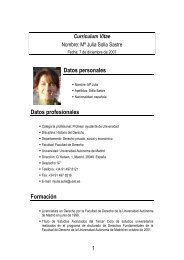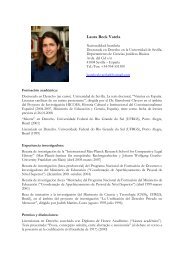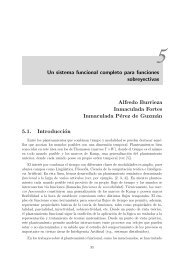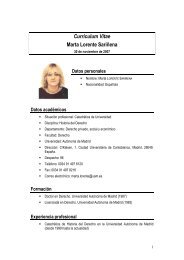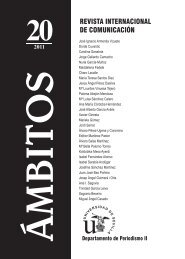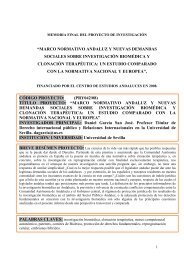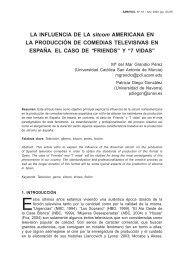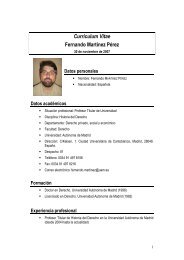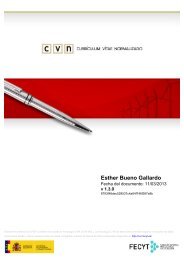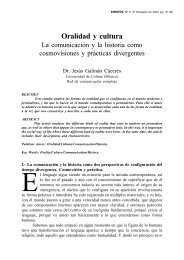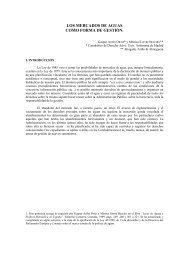expected economic benefits have become seriously questionable, due to the costsand impact on the socio-environment services that rivers have traditionally generatedas benefits for the riparian populations. It has been shown that this impact isparticularly serious in the <strong>de</strong>lta regions and coastal platforms, generatingcatastrophic effects on fisheries and other resources of great economic importance.These reasons, together with the increased social assessment of the environmental,leisure and aesthetic values of rivers, have led the <strong>de</strong>veloped countries to reconsi<strong>de</strong>rtheir hydraulic policy in <strong>de</strong>pth. As in the case of the United States and the EuropeanCommunity, policies have changed from the traditional productive approach to theecosystemic approach based on the sustainable <strong>de</strong>velopment perspective.In the present study, we will analyse the emblematic case of the Nile River and thesocio-environmental impact of the Aswan High Dam. Whilst this large scale projecthas clearly contributed towards the economic <strong>de</strong>velopment of mo<strong>de</strong>rn Egypt, it has atthe same time important ecosystem functions of the river, which have producedserious economic and environmental effects, that will be studied and assessed.Particular attention is given to the impact on the fertility of the <strong>de</strong>lta and on thefisheries of the Mediterranean Sea, especially the sardine population, that have beenseverely affected. Today, the issue of the physical sustainability of the <strong>de</strong>lta itself is inquestion, due to the reduction of the sediments and the coastal erosion. In short, it isa highly significant case in the Mediterranean context, that should serve as areference for the proposed EC Framework Directive on water policy, which iscurrently being negotiated in the core of the European Union. According to the WaterFramework Directive, the estuaries, <strong>de</strong>ltas, and coastal platforms, will need to beintegrated in river basin management.1 INTRODUCCIÓNTradicionalmente se ha tendido a consi<strong>de</strong>rar los ríos como simples fuentes <strong>de</strong>lrecurso agua, <strong>de</strong>s<strong>de</strong> un enfoque productivista que consi<strong>de</strong>ra el agua como un simplefactor productivo. Hoy en día, sin embargo, parece fuera <strong>de</strong> toda duda la necesidad<strong>de</strong> incorporar a la gestión <strong>de</strong> <strong>las</strong> aguas los valores, funciones y servicios tantosociales como <strong>ambiental</strong>es generados en los cauces, riberas, <strong>de</strong>ltas, estuarios,humedales, así como los generados por <strong>las</strong> aguas subterráneas. Se trata en<strong>de</strong>finitiva <strong>de</strong> complejos ecosistemas vivos, en continua renovación, que regeneranen cantidad y calidad <strong>las</strong> aguas que tenemos disponibles en la naturaleza. En<strong>de</strong>finitiva hablar <strong>de</strong> la gestión <strong>de</strong> un río exige incluir la gestión <strong>de</strong> vegas, bosques <strong>de</strong>ribera, humedales, galachos y estanques en sus llanuras <strong>de</strong> inundación, <strong>de</strong>ltas yacuíferos conectados con la cuenca (Worster, 1985).Hoy se tien<strong>de</strong>n incluso a integrar en la gestión <strong>de</strong> <strong>las</strong> cuencas hidrográficas <strong>las</strong>influencias <strong>de</strong>l río sobre <strong>las</strong> plataformas litorales marinas y sus ecosistemas. Dehecho la inminente Directiva Marco <strong>de</strong> Aguas que está en discusión en la UEincorpora áreas <strong>de</strong>ltáicas, estuarinas y plataformas litorales a la gestión <strong>de</strong> <strong>las</strong>cuencas.Otra cuestión fundamental a consi<strong>de</strong>rar es el hecho <strong>de</strong> que un río no sólo transportaaguas, sino que arrastra y distribuye ingentes cantida<strong>de</strong>s <strong>de</strong> sedimentos <strong>de</strong> diversocalibre, materiales solubles inorgánicos (sales) y orgánicos, lo que constituye enúltima instancia un importante transporte y distribución <strong>de</strong> nutrientes.Por otro lado, a<strong>de</strong>más <strong>de</strong> los caudales que fluyen hacia el mar en superficie, que seven claramente, hay caudales que empapan y discurren lentamente en los acuíferos,especialmente en los acuíferos aluviales asociados a <strong>las</strong> plataformas <strong>de</strong> inundación
en <strong>las</strong> zonas llanas, don<strong>de</strong> se han acumulado potentes <strong>de</strong>pósitos sedimentarios.Estos caudales, no sólo son parte <strong>de</strong>l ecosistema fluvial en estrecha relación con <strong>las</strong>aguas superficiales que fluyen por el cauce, sino que son indispensables para el<strong>de</strong>sarrollo <strong>de</strong> la vegetación a lo largo <strong>de</strong> <strong>las</strong> riberas. Junto a estas formacionessedimentarias características <strong>de</strong> <strong>las</strong> zonas bajas y llanas <strong>de</strong> <strong>las</strong> cuencas, sonparticularmente significativas e importantes <strong>las</strong> <strong>de</strong>sembocaduras y especialmente <strong>las</strong>formaciones <strong>de</strong>ltáicas.Los <strong>de</strong>ltas se forman en la <strong>de</strong>sembocadura <strong>de</strong> muchos ríos, como fruto <strong>de</strong>l equilibriodinámico entre los sedimentos fluviales aportados y la erosión <strong>de</strong> <strong>las</strong> corrienteslitorales. Estas zonas suelen ser, tanto en tierra como en el medio hídrico, <strong>las</strong> <strong>de</strong>mayor biodiversidad. Tanto la riqueza <strong>de</strong> <strong>las</strong> tierras <strong>de</strong> aluvión, con un constanteenriquecimiento <strong>de</strong> nutrientes y materia orgánica en los periodos <strong>de</strong> inundación <strong>de</strong>lrío, como <strong>las</strong> aguas dulces en interrelación con <strong>las</strong> saladas, igualmente cargadas <strong>de</strong>ricos nutrientes, han favorecido durante miles <strong>de</strong> años hábitats <strong>de</strong> extrema riqueza.De hecho se estudia cada vez con más atención la enorme importancia que tienenestos hábitats <strong>de</strong> cara al alevinaje <strong>de</strong> especies pesqueras que luego se expan<strong>de</strong>npor <strong>las</strong> plataformas litorales.Un río es un complejo conjunto <strong>de</strong> ecosistemas vivos cuya funcionalidad dinámica<strong>de</strong>pen<strong>de</strong> <strong>de</strong> múltiples variables interactivas. Des<strong>de</strong> una visión tradicional simplista seha tendido a magnificar como variables esencial el caudal, con referencia en muchoscasos al caudal medio. Hoy es ineludible consi<strong>de</strong>rar como clave, a la hora <strong>de</strong> hablar<strong>de</strong> flujos <strong>de</strong> aguas, el régimen <strong>de</strong> caudales, con sus variaciones estaciónales einteranuales y sus correspondientes funciones ecológicas, <strong>de</strong>cisivas en muchoscasos para la biodiversidad <strong>de</strong> los ríos (Allan, 1998).En este sentido, <strong>las</strong> inundaciones, <strong>de</strong>s<strong>de</strong> un punto <strong>de</strong> vista ecológico, son sucesosnaturales, cuya influencia sobre la vida en el río es tan importante como frágil.Como es sabido, <strong>las</strong> comunida<strong>de</strong>s <strong>de</strong> animales y <strong>de</strong> plantas han pasado millones <strong>de</strong>años adaptándose a <strong>las</strong> condiciones <strong>ambiental</strong>es. Las inundaciones sonsimplemente una parte <strong>de</strong> esas condiciones en el gran ciclo ecológico <strong>de</strong> los ríos.Diversas especies piscíco<strong>las</strong> esperan como primera señal, el comienzo <strong>de</strong> <strong>las</strong>inundaciones, para empezar la reproducción. Análogamente se ha podido constatarque ocurre con diversas especies <strong>de</strong> insectos para los que los procesos periódicos<strong>de</strong> inundación son referencia clave en su ciclo procreativo y <strong>de</strong> metamorfosis.Obviamente la vegetación ribereña, y la fauna que alberga, tiene una fuerte<strong>de</strong>pen<strong>de</strong>ncia <strong>de</strong>l régimen fluvial, especialmente en los tramos llanos <strong>de</strong> los ríos.Estas plantas están adaptadas a la regularidad <strong>de</strong> <strong>las</strong> inundaciones y a un nivel alto<strong>de</strong> humedad. El cambio en la periodicidad y envergadura <strong>de</strong> dichas inundacionesafecta notablemente a la flora y la biodiversidad <strong>de</strong> este tipo <strong>de</strong> hábitats. Si sepreten<strong>de</strong> preservar tal biodiversidad será fundamental por tanto gestionara<strong>de</strong>cuadamente, <strong>de</strong>s<strong>de</strong> <strong>las</strong> referencias naturales, los regímenes <strong>de</strong>l río (Alan, 1998).Otro flujo fundamental a consi<strong>de</strong>rar es el <strong>de</strong> nutrientes. De nuevo en este aspecto<strong>las</strong> inundaciones tienen un papel fundamental sobre la fertilidad <strong>de</strong> los terrenos en<strong>las</strong> inmediaciones <strong>de</strong> los ríos. Las llamadas plataformas <strong>de</strong> inundación generan <strong>de</strong>hecho <strong>las</strong> vegas y huertas más fértiles. No en vano durante cientos y miles <strong>de</strong> años,<strong>de</strong> forma periódica han recibido, no sólo sedimentos finos sino materia orgánica,nutrientes nitrogenados, fósforo, etc...Pero esta riqueza en nutrientes es por otro lado la base <strong>de</strong> la fertilidad <strong>de</strong>l río en símismo, sosteniendo una amplia fauna <strong>de</strong> invertebrados que incrementa la



